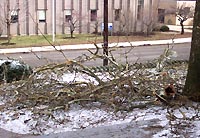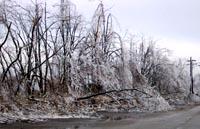Fallen Trees Beneficial for Firewood and Other Uses
Fallen Trees Beneficial for Firewood and Other Uses

Much of Kentucky was affected by the recent ice storm. Because of the abundance of damage from falling tree branches, many cities are trying to find a way to get rid of the debris.
University of Kentucky Forest Management Specialist Deborah Hill said the fallen tree limbs are an excellent source for firewood and a broad range of other uses. Trees that tipped over or will be cut down may yield short sections for woodworking, and proper sized tree sections could even be used for growing shiitake mushrooms.

Ice-covered trees fell on power lines all across northern and central Kentucky
"Lexington seems to have borne the brunt of the storm and looks like a war zone," she said. "There are tons of branches down due to the weight of the ice. People are beginning to appreciate the value of a wood-burning fireplace or stove."
Lexington and the surrounding communities are on long waiting lists for services to pick up branches and logs. Hill said the branches and logs are not uniformly cut, but can still be a great resource if people are willing to do a little work once they take the wood home.
"Local arborists and tree services are swamped with requests to clear right-of-ways and homes, so they are not going to go to great lengths to cut things into neat lengths," she continued. "But a lot of material is already piled up by the curbsides ready to be hauled away."
Hill said it may be quite a long time before the cities are able to haul away fallen branches and chip them, but if anyone wants logs or firewood now is the time to come get them.
"It will be a mutually beneficial situation," she said. "These residents need help making their communities beautiful and livable again, and there are always people who need wood for a
variety of reasons. Don't let it go to waste."
University of Kentucky Forest Management Specialist Doug McLaren said those who do bring trucks and trailers to haul away branches should always be careful of how much weight they put into their vehicles.
"Common species of wood like oak and hickory can weigh as much as 75 pounds per cubic foot," he said. "Compact trucks can hold about 30 cubic feet and larger trucks can hold as much as 60 cubic feet of cut wood, equal to 2250 and 4500 pounds respectively. So you can see how it's fairly easy to overload a truck's capacity if you go on volume alone."
According to Extension Forestry Specialist Jeff Stringer many of the damaged tress in the central Kentucky area include ornamental pear, crabapple, poplars, silver (water) maple, red maple, sugar maple, hackberry, sycamore, pin and bur oak (and other oaks), walnut, cherry and ash.
"It's important to know which of these species are worth keeping for firewood," he said. "Quality firewood means the wood gives off good heat, is cut and split properly, and is dry enough to burn easily."
Each species gives off a different amount of heat for its size. Lighter woods such as white pine, soft maples including red and silver (water maple), yellow-poplar (tulip poplar our state tree), and true poplars such as cottonwood ignite easily when dry and burn quickly. Heavy woods such as the oaks, dogwood, and black locust give off the most heat for their size.
Most of the logs and branches still are very wet, so those wanting to use it for firewood
should follow some basic guidelines.
"Once you get the wood home, it's important to let it dry out before using it," McLaren said. "Freshly cut wood can hold up to half it's weight in water, and that's in normal conditions, even more with the recent ice accumulation. "
McLaren said if wood is not properly dried, most of the energy in the fire will go toward drying the wood. This can lead to a "cold" burning fire that can lead to problems like smoldering and creosote build-up in the fireplace.
"All of the problems can be avoided just by making sure the wood is dry," he said. "And, drying wood is as easy as letting it sit outside protected from water."
Stringer added that most firewood should be cured for three or four months before it is used in the fireplace or in a stove.
"Stacks should be off the ground, covered with plywood or other similar material allowing air to circulate around the stack," he said. "Usually you can tell dry wood from green wood by the amount of cracks and checks on the ends of the pieces."
Further information on firewood can be obtained in the University of Kentucky Cooperative Extension publication FOR-35 entitled "Firewood." This publication can be obtained online through the University of Kentucky, College of Agriculture's publication listings at: www.ca.uky.edu/agc/pubs/for/for35/for35.htm.
